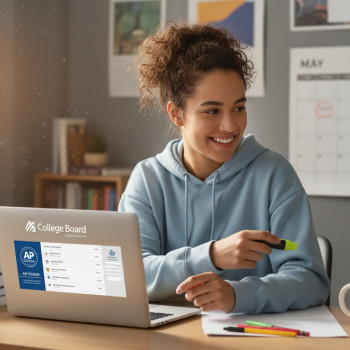Welcome — Why This Guide Matters
If you or your child is thinking about AP courses at Williams, AP exam preparation, or how tutorials and placement fit into the bigger picture of college readiness, you’re in the right place. This article is written for students and parents who want a warm, practical, and realistic roadmap — not a checklist of buzzwords. We’ll cover what AP at Williams typically means, how placement decisions happen, how tutorials can bridge gaps, and smart ways to prepare that don’t burn you out. Along the way I’ll sprinkle in examples, a clear sample plan, and how personalized help — such as Sparkl’s 1-on-1 tutoring and tailored study plans — can fit naturally into your preparation.

What “AP” Really Means at a Glance
Advanced Placement (AP) courses let motivated high-schoolers take college-level classes and potentially earn college credit through AP exams. At Williams, the focus is often on rigorous, discussion-rich learning — and AP can mean slightly different things depending on whether you’re talking about course content, college credit, or placement within college departments. For families, the key idea is this: AP can demonstrate readiness and mastery, but it’s not the only route to academic success.
Three Different Ways to Think About AP
- Curriculum: AP classes use a standardized, college-level framework. Taking AP shows you’ve tackled challenging material in high school.
- Exams: The AP Exam score (1–5) is how colleges decide whether to grant credit or advanced placement.
- Placement vs. Credit: Some schools grant credit for high AP scores; others use them for placement into higher-level courses. Understanding Williams-specific policies is important — but regardless, AP success signals academic maturity.
Navigating AP Placement and Tutorials
Placement and tutorials are ways students move into the right level of learning once they arrive on campus or within an advanced program. Placement decisions rely on AP scores, departmental exams, and conversations with academic advisors. Tutorials — structured, often one-on-one or small-group sessions — are a powerful tool for students who want targeted help in specific subjects.
How Placement Typically Works
While policies differ across departments, here’s a typical process:
- Submit AP scores and transcripts during the admissions or orientation process.
- Departments review scores and may require or offer a placement exam or interview for students who want advanced standing.
- Students who don’t meet a credit threshold might be given options: take an introductory course, enroll in a higher-level course with a co-requisite, or use tutorials to catch up.
Remember: placement is not a lifetime verdict. If you start at one level and discover you’re ready for more, departments are usually flexible — talk to your instructor or advisor.
Why Tutorials Can Be a Game-Changer
Tutorials are not remedial. When well designed, they’re targeted, efficient, and respectful of your time. They help you move from understanding to mastery: clarifying tricky concepts, building problem-solving habits, and creating assessment-ready skills.
When a Tutorial Makes Sense
- You scored well, but feel shaky on core ideas needed for higher courses.
- You’re entering a new subject area and want to accelerate without gaps.
- You learn best through conversation, worked examples, and immediate feedback.
For many students, a short tutorial sequence — say, 6–12 sessions — can unlock confidence and course options that would otherwise feel out of reach. Personalized tutoring, such as Sparkl’s 1-on-1 guidance, can be especially effective here: tutors can create a study pathway that aligns with AP topics, placement expectations, and your personal learning style.
Designing Your AP Season: A Practical Timeline
Instead of one-size-fits-all plans, here’s a flexible timeline you can adapt. It assumes an AP exam in May and builds in pacing, practice, and recovery so you’re sharp without being exhausted.
| Timeframe | Focus | Goal |
|---|---|---|
| August–September | Foundations and Routine | Set syllabus map, daily study blocks, and identify weak zones. |
| October–December | Content Mastery | Finish big units, solidify frequently-tested concepts, begin timed practice. |
| January–March | Applied Practice | Full-length practice tests, targeted tutorial sessions, and feedback loops. |
| April | Refinement | Polish essays/free-response strategies, review error logs, simulate exam conditions. |
| May | Exam | Peak performance: rest, strategy, and controlled confidence. |
Tips for Each Phase
- Foundations: Build a lightweight schedule you can keep. Even 30–45 focused minutes daily is better than four hours once a week.
- Content: Use concept maps and teach-back methods: explain topics aloud to a friend or tutor.
- Applied Practice: Emphasize past free-response and multiple-choice items under timed conditions.
- Refinement: Stop learning new content two weeks before the exam; switch to active recall, spaced repetition, and exam strategy.
Study Methods That Actually Work
AP success depends less on raw hours and more on how you use those hours. The following methods are high-yield and student-tested.
Active Techniques
- Spaced Repetition: Review increasingly spaced intervals to lock facts into long-term memory.
- Interleaving: Mix problem types in practice sessions rather than blocking one topic for a long time.
- Timed Practice: Replicate exam conditions — time constraints change how you read and answer.
- Error Logs: Track mistakes, categorize them (conceptual, careless, time), and target the biggest buckets.
Combine these with personalized coaching — for example, Sparkl’s tutors can create AI-informed insights on your practice patterns and design drills for your weakest categories. That keeps practice efficient and targeted.
Sample Weekly Study Plan (for a Single AP)
Here’s a sustainable weekly routine that balances schoolwork, practice, and rest.
| Day | Activity | Duration |
|---|---|---|
| Monday | New content review + short problem set | 60–75 min |
| Tuesday | Practice questions (timed sections) | 45–60 min |
| Wednesday | Tutorial or study group (focused topic) | 60 min |
| Thursday | Flashcards / spaced repetition | 30 min |
| Friday | Full practice free-response or mixed set | 75–90 min |
| Saturday | Long-form review or mock test (biweekly) | 2–3 hrs (on mock test weeks) |
| Sunday | Rest, light review, strategy planning | 30–45 min |
Balancing AP Workload with Well-Being
Ambition is admirable — burnout is not. The students who do best manage time, sleep, and perspective. Here’s how to keep balance without sacrificing results.
Practical Balance Rules
- Sleep First: Memory consolidation requires sleep. Prioritize consistent bedtimes, especially the week before an exam.
- Microbreaks: Study in 45–60 minute blocks with 5–10 minute breaks to stay sharp.
- One Big Priority: Each week pick one major task to finish (e.g., a mock exam or a long practice essay). Small wins build momentum.
- Reflect, Don’t Panic: Weekly reflection on what’s improving and what’s stuck is more useful than random extra hours.
How Parents Can Support Without Taking Over
Support looks different at each stage. The best parental moves are practical, calm, and encouraging.
Concrete Ways to Help
- Provide a predictable study space and a quiet exam morning routine.
- Ask questions that invite reflection (“What was one win this week?”) rather than issuing directives.
- Help arrange tutoring or tutorials if more structure is needed — a short series of targeted sessions often does more than indefinite supervision.
- Respect sleep and downtime; modeling balance reduces friction and stress for students.
For families exploring tutoring options, consider services that offer a mix of expert tutors and data-driven progress tracking. Tutors who can translate AP rubric language into actionable steps — and who coordinate with your child’s pace — are the best investment.
Realistic Expectations About Scores and College Credit
AP scores range from 1 to 5. A 4 or 5 usually indicates strong mastery, but different colleges have different policies for granting credit or placement. Instead of chasing a specific number at all costs, focus on demonstrating consistent mastery and problem-solving skills in your subject. If a particular department at Williams or elsewhere uses AP for placement, the conversation often continues after arrival — through placement exams or advisor meetings.
What to Do If Your Score Isn’t What You Hoped
- Remember it’s one data point. Explain the context in essays or interviews only if there’s a meaningful story (e.g., illness or extraordinary circumstances).
- Plan a recovery: enroll in a college course or take a tutorial to fill gaps and show mastery in future work.
- Use targeted tutoring: a concise set of sessions focusing on exam-style questions can close a score gap faster than long unfocused studying.
Case Studies: Two Students, Two Paths
Stories help make abstract advice concrete. Here are two short examples drawn from common student experiences.
Case A — Maya: The Confident Tipper
Maya took AP Calculus and scored a 3 on the exam. She knew her conceptual understanding was solid but she lost points on timed questions. She scheduled four focused tutorial sessions focused on exam pacing, practiced past paper sections, and improved test-taking strategy. By the time she arrived at college, she felt prepared to take a higher-level class because she had closed the pacing gap. Her advisors accepted her into a more advanced sequence based on her focused work and confidence.
Case B — Jamal: The Late Bloomer
Jamal took AP Biology but lacked foundational chemistry, which showed in his exam score. Instead of repeating the entire course, he took a short placement course and used tutorials to shore up chemistry skills. He combined targeted sessions with weekly lab practice and arrived at college ready for intermediate coursework. The tutorial approach saved time and preserved his interest in biology.
How to Choose a Tutor or Tutorial Program
Not all tutoring is created equal. Here’s how to pick a program or tutor that will actually move the needle.
Checklist for High-Value Tutoring
- Goal Alignment: Tutor asks about your goals (placement, credit, scholarship) and tailors sessions accordingly.
- Diagnostic Start: A quick diagnostic helps identify the highest-impact areas to improve.
- Concrete Metrics: Look for progress measures (e.g., percent correct in timed sections, rubrics for free-response improvement).
- Communication: Regular feedback loops for both student and parent without micromanagement.
- Flexibility: Tutors who can pivot between content, strategy, and time-management coaching are most effective.
Sparkl’s personalized tutoring often fits these criteria: 1-on-1 guidance, tailored study plans, expert tutors, and AI-informed insights that can accelerate progress while keeping the workload humane. If your student responds well to personalized attention, a short, intense tutorial sequence can create outsized gains.
Final Thoughts: A Plan That Grows With You
AP courses, placement, and tutorials are tools — not trophies. Use them to deepen curiosity, practice rigorous thinking, and build a study process that serves you across college and beyond. Whether you aim for multiple AP credits, a strategic placement to skip an intro course, or a tutorial to shore up a shaky topic, the best strategy balances ambition with sustainable habits.
Start early, keep your plan simple, track progress, and use short, focused interventions when you need them. And if personalized help fits your learning style, consider a structured program that combines expert tutors, tailored plans, and clear metrics for improvement — the kind of support that helps you build momentum without losing balance.

Ready to Take the Next Step?
Map one concrete next action: schedule a diagnostic test, book a short tutoring block, or set a mock-exam date three months out. Small, planned steps compound. With steady work, smart strategy, and the right support — including targeted tutorials when needed — AP and placement become opportunities rather than obstacles. Good luck, and remember: the process you build now is practice for the kind of learning you’ll do in college and beyond.
Friendly reminder: every student’s trajectory is unique. Use this guide to make pragmatic choices that keep curiosity, growth, and well-being at the center.


















No Comments
Leave a comment Cancel